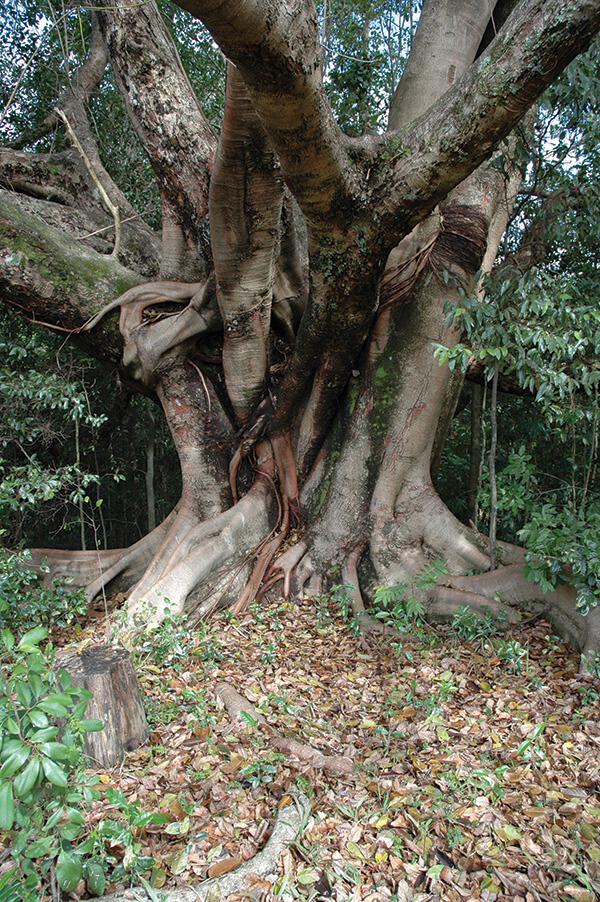
We purchased our property at Hunchy on the Sunshine Coast in 1990 but did not move here from interstate until 1997. Like typical absentee owner properties, the weeds grew and neighbourhood cattle grazed on patches of ‘free’ grass.
An early settler’s map from 1895 of our property noted ‘vine scrub’ and an area of good loam soil. I’m not sure where the soil went but probably down a creek! Other early surveyor’s maps noted extreme rugged country and dense vine scrub (1900) and an area of dense Lantana (1921). At this time the main occupation in Hunchy was dairying but clearly Lantana had already taken hold. Over time, the valley was almost totally cleared for small crops (vegetables), dairying, bananas and fruit trees. These days beef cattle graze on some properties.
We initially thought that the original vegetation for the area was dry vine forest, but we now know that the original vegetation, or ecological community, was rainforest. It is officially titled Lowland Rainforest of Subtropical Australia. This ecological community is found on the basalt and alluvium of north-east NSW and South East Queensland. It is also defined by altitude and rainfall. First Nations people of the Sunshine Coast managed these rainforests and depended on them for fibre, food and medicine.
Lowland subtropical rainforest contains diverse tree flora, buttresses and an abundance and diversity of vines plus a sparse understorey.
Anecdotally the early cedar cutters referred to Hunchy as Bastard Scrub. Some Red Cedars can still be found and could well be seedlings from the original trees. Figs abound, mostly Ficus virens, Ficus fraseri and Ficus coronata. On our property, we are the lucky custodians of a magnificent Ficus virens under which our neighbour occasionally sheltered with her horse about 70 years ago on the way to the one room, single teacher Hunchy School, built in 1924 and now our community centre. Thanks to the figs, our property is becoming a haven for the frugivores, particularly pigeons/doves. A high proportion of frugivorous birds is a characteristic of this ecological community.
Once we moved to our property, we commenced our long-term revegetation and rehabilitation program and joined Land for Wildlife. Almost all of the listed canopy, sub-canopy and understorey species for this vegetation type have been planted. Some were already present. A few apparent remnant trees grew in deep gullies but could equally be regrowth. Our Land for Wildlife Officers and Barung Landcare supplied advice and plants. Maximising diversity has been a consistent aim. Level areas are scarce, and we have found over time that the water holding capacity of our soil varies greatly with the terrain and the extent of past colluvial slips.
Our diverse plantings supply nectar, fruit, seeds and plenty of insects for most birds listed for this ecological community. As weather patterns change with global warming, we are looking north beyond the Blackall Range to drier areas for species selection as anything we plant now will outlast us by many years.
Many of our neighbours are also undertaking revegetation projects to the extent that the upper part of our valley is clearly becoming re-forested. Wildlife corridors have been established, particularly along creek and gully lines and are expanding. It won’t be the original ecosystem, but it seems the present wildlife generation is not concerned. We compare notes about the birds in our patches, both permanent and migratory and where the wallabies are feeding. A female Regent Bowerbird recently bathed so vigorously in one of our water dishes that she just about emptied it.
Near vertical slip faces are still clothed in Lantana but with Ficus virens planted on top and revegetation by our neighbour below, it will eventually be shaded out. Our social community is also a community of tree-planters as are others across the Blackall Range. We’re not quite finished but natural regeneration is playing its part and older cleared areas are almost unrecognisable. It has been a very rewarding journey.
Article and photos by Joan Dillon
Land for Wildlife member
Hunchy, Sunshine Coast
View Full Newsletter
